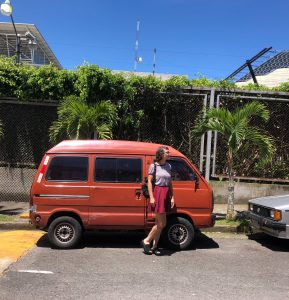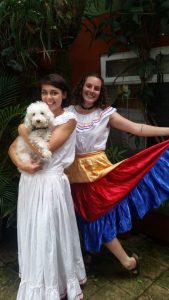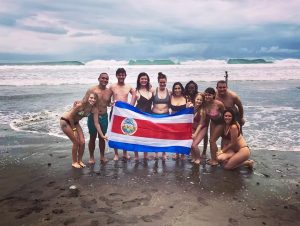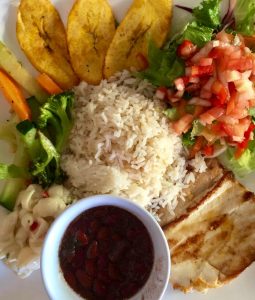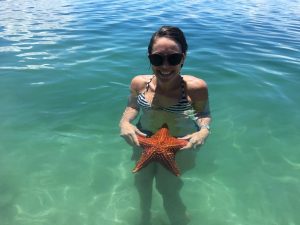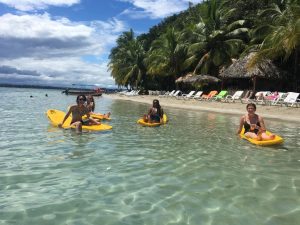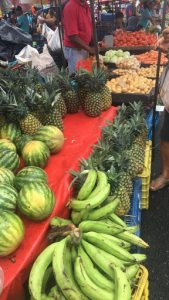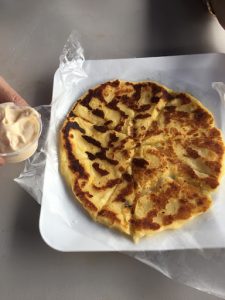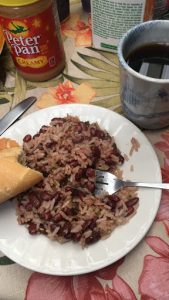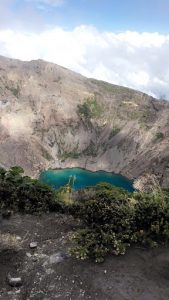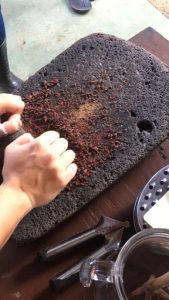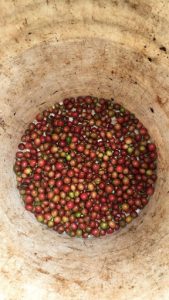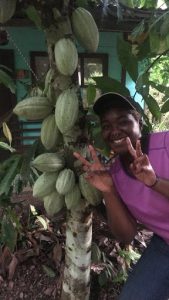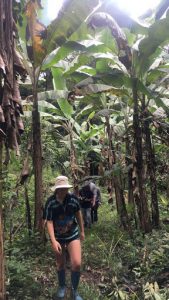Rebecca Ferguson
ISA San Jose, Costa Rica: Spanish Language, Liberal Arts & Environmental Studies – Semester
Major: Environmental and Global Studies
Jump to: Sept. 2018, Oct. 2018, Nov. 2018
Hi
¡Hola de Costa Rica!
Hello from Costa Rica!
My name is Rebecca Ferguson, I am an Environmental and Global Studies double major, and I am now studying in San Jose, Costa Rica.
Called Chepe by the local Ticos, the capital of Costa Rica is where half of the country’s five million people reside. This city, nestled in the central valley and surrounded by volcanoes, is bustling with congested traffic, open markets, and people of all backgrounds.
I live with a Costa Rican woman, my “mama tica” Ana, Chloe, a student from Colorado, and a half-blind little dog named Tofito. Our comfortable home is on a busy street around the corner from the Universidad Veritas, where for the past month I have been attending a four-hour long Spanish class every morning.
Two weeks ago, we celebrated La Dia de Independencia, Costa Rica’s independence day, by wearing traditional dresses, making lanterns, and going to a parade.
Costa Ricans, or Ticos, generally live by the mantra ”¡Pura Vida!”, meaning something like “it’s all good”. Lately, however, labor unions from all sectors have been on strike because of a proposed law that would primarily increase taxes on goods and add a tax to services. The strikes are a huge topic of debate and sometimes cause difficulties in getting around, but are generally peaceful.
I chose to study abroad in Costa Rica for the country’s world-renowned efforts in sustainability, its gorgeous national parks and beaches, Spanish language, and latin culture. During the week, I visit art and history museums, sodas (small restaurants with typical dishes like casado), cafeterias (for coffee and pastries), yoga, and dance classes to learn salsa, bachata, and merengue. On the weekends, the other students from my program and I flock to the beaches, which are a three to six hour bus ride away to see waterfalls, tropical wildlife, and surfers.
Last night I was visited by UMBC’s very own Markya Reed ‘18, who is in her fourth month of Peace Corps training right outside of San Jose. While I haven’t felt extremely homesick, it felt so comforting to share a meal and conversation with someone from Baltimore. The things I miss include my family and friends (of course), my cat, and really great bagels.
I am in the last week of my first intensive Spanish course and will be starting a new schedule with electives next week.
Until then, ¡Chao!
October 2018
Hola UMBC!
I have had quite the unique experience these past couple of weeks. The ISA program brought us to Bocas del Toro, Panama for a long weekend to renew our tourist visas and relax after an intense month of Spanish language classes. We took a boat tour of the islands, where we saw sloths, dolphins, starfish, and the most beautiful beaches I have ever seen.
The small tourist town had mostly restaurants and souvenir shops. After dinner, my friends and I swam in the pool and found a hole-in-the-wall bar with great burgers (have you ever had a hotdog on a burger?), craft beer, and a hidden pier that became a dance floor where locals showed us up with their salsa, merengue, cumbia, and bachata moves.
The eight hour bus ride back to Costa Rica, however, was less than relaxing. I became very ill and went to the emergency clinic immediately upon arriving back to San Jose. After a week of testing, I was admitted to the hospital. I had leptospirosis, a rare bacterial infection that caused me to have meningitis. My doctor, nurses, and lots of penicillin saved my life.
My mom came to be with me in the hospital and we were able to spend some time exploring the city when I was released from the hospital. My momma tica took up to the feria verde, a huge farmer´s market. She made us try all the tropical fruits we had never seen before, the tico equivalent of pizza, and jugo de caña, which is literally sugar cane juice.
Now, the Study Abroad Office is probably thinking they chose the wrong student ambassador to write this blog, and you’ve changed your mind about ever leaving the states, but hear me out. I had a near death experience and started the semester three weeks late and while most of my peers thought I would return home after recovering, I decided to stay. I studied abroad in order to gain a new perspective, and my unique experience gave me just that. I am so grateful for my body and my life, and have realized my mortality in a way I could not possibly understand before. Do something that scares you everyday, and be honest with yourself and others about how you feel, even if it is difficult. No one grows from a comfortable life.
November 2018
Rainy season in Costa Rica is almost over and life is returning to a state of equilibrium. I am feeling stronger everyday. After eating montañas of my mama tica´s gallo pinto, a mix of beans, leftover rice, chopped onions, peppers, and Lizano (a local sauce) every morning and going to yoga classes especially.
Last weekend we visited an active volcano, Irazu, which last erupted in 1994. I was… cold? Despite me wishing I had gloves and a scarf, it really hit me how much I missed those cozy, cool fall days back home. The volcano was beautiful and it was fascinating to learn about the vegetation that adapted to living in the ashy soil.
This weekend my Agroecology and Tropical Botany classes had a field trip to three sustainable farms. This was my favorite trip yet and we didn’t even have wifi! For me, personally, visiting the best beaches in Costa Rica cannot compare to picking coffee beans, making chocolate from cacao fruit, eating said chocolate, and trekking through the rain (and mud) to a gorgeous waterfall. We learned how to make use of kitchen scraps, various types of manure, and decaying leaves from the forest into very nutrient rich, and surprisingly non-smelling, compost and how to make both coffee and chocolate from fruit to deliciousness.
Using permaculture methods and agroforestry, the farms were practically disguised in the surrounding jungle. By integrating the natural environment into the design of the farms, the farmers can produce the organic fruits, vegetables, medicinals, fibers, and building materials needed to sustain themselves, and contribute significantly to the local economy.
Did you know that it takes almost a year to produce a single pineapple? The non-organic industry cannot produce them fast enough to meet the market demand and so the pineapple industry is one of the most chemically intensive, using hormones to make the plants fruit faster. The industry accounts for nearly 10% of the country’s economy but also has caused soil and water contamination, indigenous land losses, exploitation of farmers rights and health. The ticos are aware of the issues, but I might not have ever known if I hadn’t spent some time at the farm. Just something to consider the next time you’re grocery shopping.
